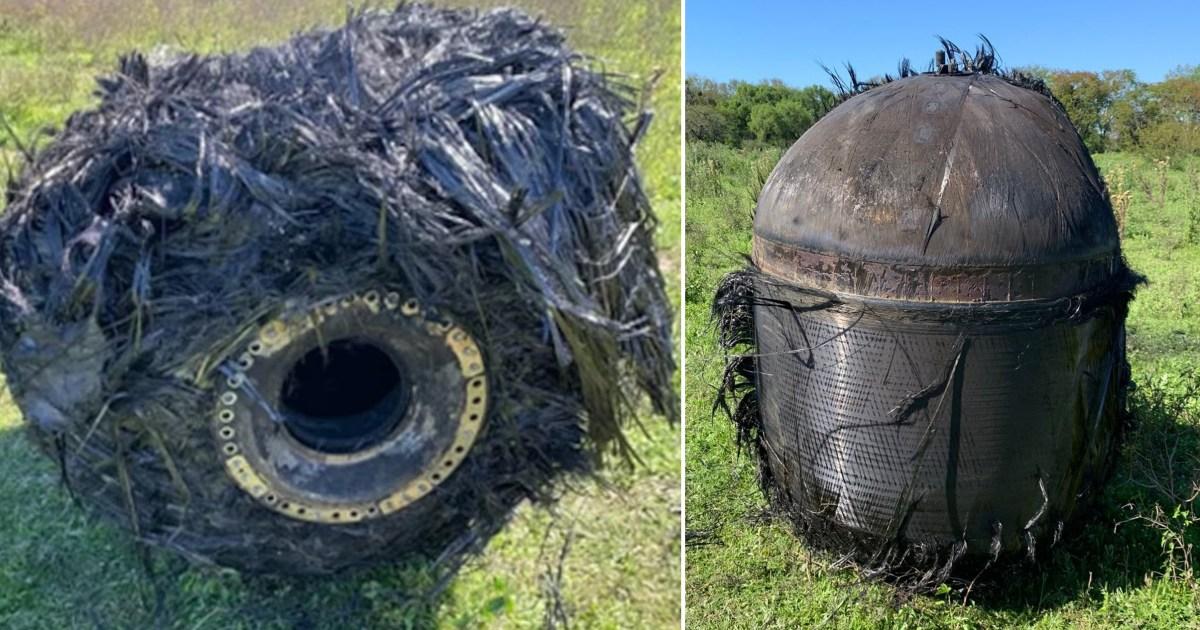World
Space Junk Plummets to Earth, Lands in Argentine Farmer’s Field

A large cylindrical object, identified as space debris, fell from the sky into a farmer’s field in Puerto Tirol, Argentina, on the evening of March 14, 2024. The incident has captured significant attention from local residents and authorities alike. The object, measuring approximately 1.7 meters long and 1.2 meters wide, belongs to farmer Ramón Ricardo González, who promptly reported the unusual find to the police.
Following the alert, authorities dispatched bomb disposal experts to assess the situation. Their primary concern was to determine whether the object posed any explosive risk or contained hazardous materials. Initial investigations revealed a serial number etched into the surface, indicating that the object is debris from a spacecraft. According to the Chaco Police Headquarters, it has been confirmed that the object is a rocket fuel tank capsule.
Experts examining the debris have classified it as a composite overwrapped pressure vessel (COPV), a high-tech type of tank commonly used in aerospace applications. The cylindrical structure features an internal valve system and is covered in frayed fibrous material, indicative of damaged carbon fiber. These tanks are designed to store fuel fluids under high pressure while remaining lightweight, making them suitable for rocket launches.
While the precise origin of the tank remains unclear, reports suggest it may be linked to a recent launch of a Jielong 3 rocket, which took place on March 13, 2024. This rocket was launched from a vessel off the coast of China, and Mr. González’s field falls directly beneath its known flight path. Residents across various parts of Argentina reported witnessing a strange glowing object traversing the sky on the night of the launch.
The incident highlights a growing concern regarding space debris, which has become increasingly prevalent as the number of spacecraft launches rises. The European Space Agency (ESA) reported that approximately 1,200 intact space objects re-entered Earth’s atmosphere in the previous year alone. The total number of debris fragments that fell is believed to be significantly higher, though challenging to quantify.
Currently, the ESA estimates that over 45,000 pieces of debris larger than 10 centimeters in diameter are orbiting the Earth, alongside millions of smaller fragments. Despite the rising number of re-entries, there has never been a recorded fatality due to space debris. The risk of injury remains low, largely because most debris burns up upon re-entry, and much of the Earth’s surface is either covered by water or uninhabited land.
As the investigation continues, authorities are working to further analyze the fallen object and ascertain its complete origin and implications for future space missions. This incident serves as a reminder of the complexities and challenges posed by increasing space activities in an era of expanding satellite markets and technological advancements.
-

 Entertainment3 months ago
Entertainment3 months agoAnn Ming Reflects on ITV’s ‘I Fought the Law’ Drama
-

 Entertainment4 months ago
Entertainment4 months agoKate Garraway Sells £2 Million Home Amid Financial Struggles
-

 Health3 months ago
Health3 months agoKatie Price Faces New Health Concerns After Cancer Symptoms Resurface
-

 Entertainment3 months ago
Entertainment3 months agoCoronation Street’s Carl Webster Faces Trouble with New Affairs
-

 Entertainment2 weeks ago
Entertainment2 weeks agoCoronation Street Fans React as Todd Faces Heartbreaking Choice
-

 Entertainment3 months ago
Entertainment3 months agoWhere is Tinder Swindler Simon Leviev? Latest Updates Revealed
-

 World2 weeks ago
World2 weeks agoBailey Announces Heartbreaking Split from Rebecca After Reunion
-

 Entertainment4 months ago
Entertainment4 months agoMarkiplier Addresses AI Controversy During Livestream Response
-

 Science1 month ago
Science1 month agoBrian Cox Addresses Claims of Alien Probe in 3I/ATLAS Discovery
-

 Health5 months ago
Health5 months agoCarol Vorderman Reflects on Health Scare and Family Support
-

 Entertainment4 months ago
Entertainment4 months agoKim Cattrall Posts Cryptic Message After HBO’s Sequel Cancellation
-

 Entertainment3 months ago
Entertainment3 months agoOlivia Attwood Opens Up About Fallout with Former Best Friend















